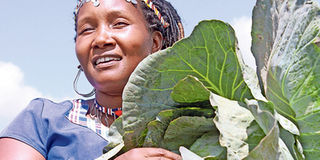Drought? Life just got rosier

Kabaa assistant chief Rosena Nzisa displays a cabbage in her farm in Machakos. She harvests the vegetables at least twice a year. PHOTO | PIUS MAUNDU | NMG
What you need to know:
- Though the administrator also grows tomatoes, bananas and maize at the adjacent plots, she prefers to be identified with the cabbages.
- The seedlings are transplanted after a month. Agronomists recommend that watering should be at least once a week.
- But with rain or no rain, water is not a problem in the area served by a seven-kilometre canal that runs alongside the river.
- The cabbage enterprise is not for the faint-hearted. Much of the production costs go to ploughing, hiring farmhands who weed, spray and apply fertiliser.
The winding trail of fruit and vegetable sellers’ vehicles slows down and eventually stops at Kithimani market off the Garissa-Nairobi road.
It is a culture that has defined the market and which is sustained by hundreds of smallholder farmers, among them Rosena Nzisa.
The Kabaa assistant chief grows crops in the neighbourhood using water from River Athi.
She is harvesting conventional and Chinese cabbages at a corner of her farm when the Seeds of Gold team arrives.
“You will find me at the farm when I am not at the office,” Nzisa says during a guided tour of the one-acre plot teeming with thousands of cabbages at various stages of maturity.
Though the administrator also grows tomatoes, bananas and maize at the adjacent plots, she prefers to be identified with the cabbages.
“The globemaster variety matures fast and fetches us good money as it is also heavy,” the mother of four who started farming five years ago says.
“The first step in growing cabbages is preparing the nursery. To get seedlings for an acre, we use 150 grams of seeds in the nursery. The seeds cost Sh9,000,” she says.
“We hire a tractor to plough the plot, then make furrows in readiness for planting.”
Shallow basins at the seedbed ensure that water is preserved.
The seedlings are transplanted after a month. Agronomists recommend that watering should be at least once a week.
“We prefer transplanting seedlings shortly before the rains begin. This saves on irrigation costs and labour,” Nzisa says.
REAPING MORE
But with rain or no rain, water is not a problem in the area served by a seven-kilometre canal that runs alongside the river.
The canal, which was funded by the African Development Bank and the government, has transformed the arid region into a food basket.
“One acre produces at least 8,000 cabbage heads. Ordinarily, traders come for the produce at the farm,” the chief says, adding that she makes around Sh200,000 per harvest.
She harvests cabbages at least twice a year.
Now, as the country experiences a long drought, Nzisa and her fellow farmers are reaping more.
“I drew inspiration from my parents, who used to grow maize and beans and sell to schools. I also took up farming to inspire the youth and women,” she says.
The cabbage enterprise is not for the faint-hearted. Much of the production costs go to ploughing, hiring farmhands who weed, spray and apply fertiliser. They also harvest.
Leasing an acre of the land is between Sh25,000 and Sh30,000 a year.
“The emergence of new pests, which is a common phenomenon, means a reduction in the profits as too,” says Rosena.
The farmers sell their produce locally, and this is how the vegetables find their way to Kithimani, Masii and Matuu in Machakos County, and Tawa in Makueni County.
This way, they save on the costs and inconveniences of transporting their produce to faraway markets.





